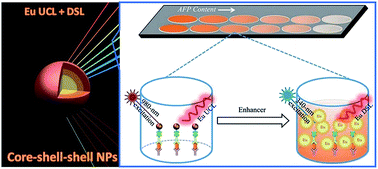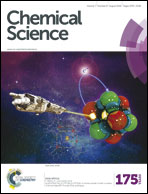In vitro upconverting/downshifting luminescent detection of tumor markers based on Eu3+-activated core–shell–shell lanthanide nanoprobes†
Abstract
Trivalent europium (Eu3+) doped inorganic nanoparticles (NPs), emerging as a new class of red luminescent nanoprobes, have shown great promise in bioapplications as diverse as luminescent bioassays and disease theranostics owing to their superior optical properties such as long-lived downshifting luminescence (DSL) and upconverting luminescence (UCL). However, the exploration of Eu3+-doped NPs as red luminescent bioprobes particularly combined with DSL and UCL of Eu3+ hitherto remains untouched. Herein, we report a rational core–shell–shell (CSS) design strategy to construct Eu3+-activated NaGdF4:Yb/Tm@NaGdF4:Eu@NaEuF4 CSS NPs functionalized with efficient UCL and dissolution-enhanced DSL of Eu3+ for in vitro tumor marker detection and tumor-targeted imaging. By utilizing the CSS NPs as red luminescent nanoprobes, we demonstrate the successful UCL and DSL bioassays of a typical hepatic carcinoma biomarker, alpha-fetoprotein (AFP), in human serum samples. The UCL bioassay shows a limit of detection (LOD) of AFP down to 20 pg mL−1 (290 fM), which is the lowest among luminescent bioassays of AFP ever reported, and a 30-fold improvement relative to that of the commercial dissociation-enhanced lanthanide fluoroimmunoassay kit. Meanwhile the DSL bioassay, by employing the identical CSS NPs, can serve as a self-referential validation for the reliability and accuracy of the UCL bioassay for AFP detection. Furthermore, these CSS NPs can also function well in tumor-targeted UCL bioimaging, thereby revealing the great promise of the designed CSS NPs as red luminescent bioprobes in ultrasensitive in vitro detection of tumor markers in clinical diagnosis.

- This article is part of the themed collection: Global challenges: Health & Food


 Please wait while we load your content...
Please wait while we load your content...